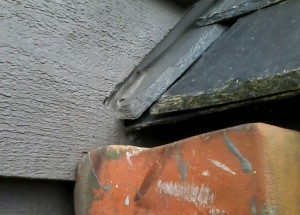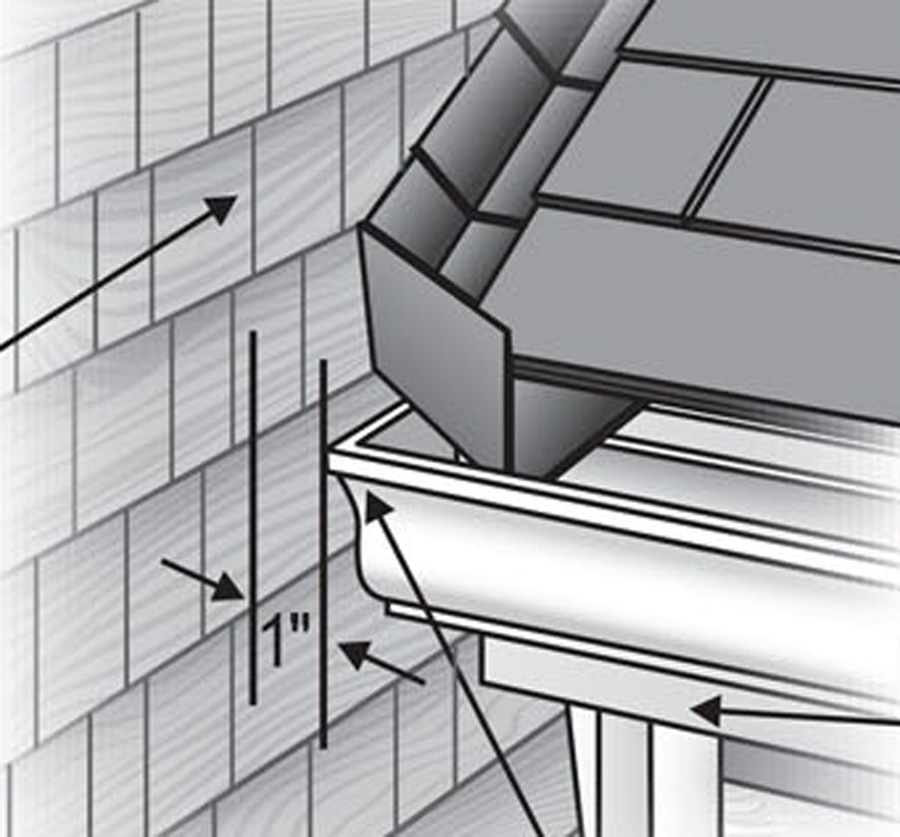Lack of kick-out flashing is responsible for millions of rotting walls in homes across the USA and the World. This is a new code requirement and just about no one knows about it.
Well, your architect-friends at HOME ARCHITECTS ® do know about this, and are here to make sure that your new house design and renovations have this so that your walls and windows won’t rot the way that millions of houses across America and the World are presently doing.
Kick-Out Flashing Solves Problems
Rand Soellner ArCH/NCARB/LHI is a licensed residential architect. He also happens to be a licensed Home Inspector and in addition to designing very nice houses, also diagnoses problems (in houses and buildings designed by others) as a forensic architect. He has seen several problems of epidemic proportion developing in built houses across the country and has discussed these issues with County building officials, builders and other professionals whom have also recognized these problems. One of these issues has to do with Kick-Out Flashings.
Lack of Kick-Out Flashing: the problem
Kick-Out Flashings are referred to, but not by that name, in a NEW CODE SECTION in the 2012 IRC (International Residential Code). It is on page 441 of this 904 page volume: Section R905.2.8.3 Sidewall Flashing. New code sections are identified by a solid black vertical bar running beside the new text in the IRC. This item is solid black for the entire paragraph.

So what is the big deal? Well, it turns out that since humankind invented buildings and built houses, this situation has been around, particularly when 2 story houses started being created. When a vertical wall is up against a sloping roof, you are supposed to flash that joint. Flashing is typically metal. Typically galvanized steel or aluminum, often with a factory paint coating to give it added durability and a more finished appearance. Sometimes copper is used on more elaborate projects. Okay so far? The metal goes in the joint between the vertical wall and the horizontal roof. Quite often this flashing is stepped and worked into each course of roofing shingles, to insure that any water penetration will harmlessly flow out the joint and over the flashing and back onto the roof, lower down in the joint.
Now when you get to the bottom of this joint is where the trouble begins. Just about no one has ever done anything about the build-up of water that can happen in this joint. Because it does abut a higher surface (the vertical wall), wind blown rain can circulate in vortices and collect in this area, resulting in quite a lot of rain water flow coming down at the bottom of this joint. Okay so far?
So, here is all this rainwater, running lickety-split down this flashing joint. What everyone would LIKE to have happen now, is for all this water to harmlessly spill into a gutter at the bottom (or eave drip). Unfortunately, it is not good for gutters to actually contact the wall, because if they ever start leaking, this is like have a duct full of water directly pushing water into your wall. So, alright, let’s separate the gutter from the wall by, say, an inch.
Once again, let’s look at what all this water ACTUALLY does: it does NOT harmlessly and gently flow into the gutter. Instead, it is moving very quickly and over-shoots the gutter and pours over the surface of the continuing vertical wall below this point (or window, or door, or whatever happens to be there, below this point). What do you suppose happens to this surface, over time? If it is made entirely of stainless steel, perhaps nothing. But that is not what is typically there. No. Usually it is wood siding in a residence. Wood does not like being in a submarine, which is what is happening: constant inundation of water, every time it rains. Over time, all of this water being dumped on this lower wall finds its way into it and rots the surface finish material, gets into cracks and crevices and rots the internal wall studs, destroys and contaminates the wall insulation with mold, and generally ruins anything in its path, including windows and other elements.
Rand Soellner has seen this in various inspections, some of which have to do with failing roofs, walls, and windows. Here is one photo of this situation (above, to the left), where there is NO Kick-Out Flashing. Note that the roof shingles do have the normal edge flashing where the roof slope touches the wall on the left side. Good so far. Only, also note that the siding is stopped above this flashing (it’s supposed to be at least 2″ and in this situation it looks more like about an inch or less), and that’s okay too. But notice what then happens: the siding below creates a dam. The flashing is now directing water moving along that joint and into that wall siding thickness dam, where the water can enter the interior wall, by flowing behind the wall finish.
Now that we understand the problem: water running down the wall-to-roof flashing joint and into this dam condition, what can we DO about it? Just watch that rainwater rot our walls helplessly? Wring our hands and hope it never rains again? We don’t think so.
Kick-Out Flashing: the solution
Something can be done and, as required by the new code, must be done (although we have NOT seen Anyone, anywhere doing it yet, except on our projects). The answer? KICK-OUT FLASHING. This is a bend in the side wall flashing at the bottom, that DIVERTS the water flowing downward, AWAY from the wall and toward the gutter. See details below. This prevents the water from entering the dam condition spoken of above. NOW, the water can and will harmless go to the gutter, and IF it tries to overshoot the gutter, due to a high volume or high velocity, at least it will be heading in a direction away from the wall. Unfortunately, minimum code does Not always solve problems and we have many online articles explaining this. However, this is one that they got right.

Yeah, we know what you’re thinking: “Geez! All this fuss over a little piece of metal! Is it really worth it?” Well, let’s examine some economic facts and see if it would matter to you. We recently conducted a forensic study of a client’s house. All of the windows had failed and were leaking. In addition, there was no Kick-Out Flashing. Yes: this is a new requirement, so no one that had designed or built that house did anything legally wrong (and no, we did not design it). The homeowner estimates that his removal and replacement of rotting walls and windows to be somewhere in the vicinity of $50,000. The house is only 8 years old. What you do if that happened to your house? Get mad at someone? How about getting mad at yourself? What do we mean? Well: now that you KNOW about this situation and also know that very few other people in design and construction know about it, what are you going to do to insure that your new project does not have this problem? How about: hire an architect that knows how to solve this very technical condition? That’s an easy answer!
Who to call for expert design and detailing
And just who might this be? Consider contacting:
Rand@HomeArchitects.com 828-269-9046.
tags: kick-out flashing, atlanta, georgia, aspen, telluride, chicago, paris, dubai, las vegas, canada, hendersonville, post and beam
